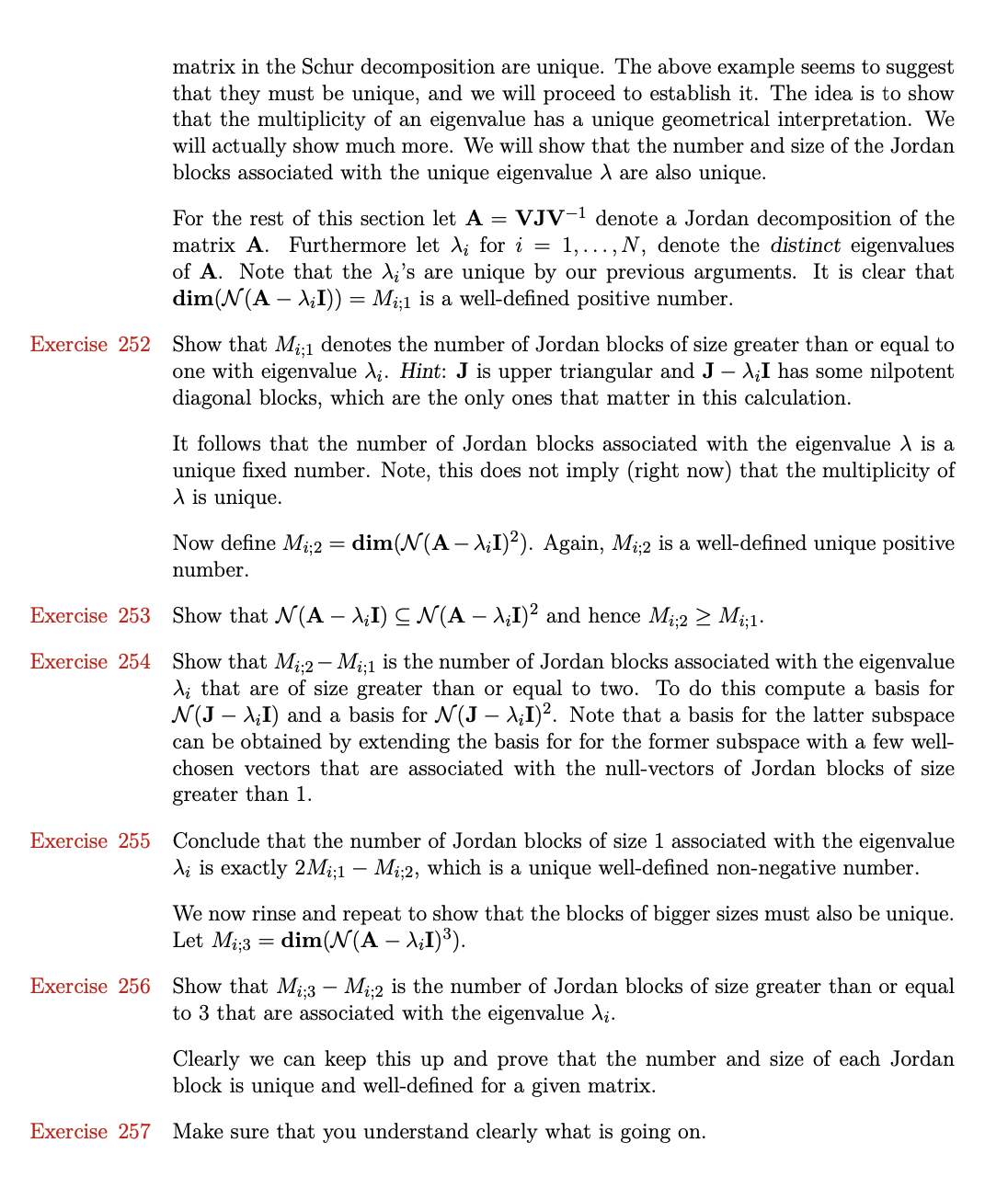Could you please help with question 256 and 257? Thanks
Eigenvalue Eigenvector Invariant subspace Similarity transformation Exercise 248 Exercise 249 Lemma 7 Exercise 250 Example 4 Exercise 251 5.2 Invariant subspaces Jordan chains made a magical appearance in the proof. A good way to see how they arise is to consider the uniqueness of the decomposition. A complex number A such that A AI is singular is called an eigenvalue of A. A non-zero column vector v is said to be an eigenvector associated with the eigen- value A of the matrix A if Av = Av. A subspace V is said to be an invariant subspace of the matrix A if for every v 6 V we have Av 6 V. A matrix A is said to be similar to a matrix B if there exists a non-singular matrix V such that A = VBVil. We also say that A and B are related by a similarity transformation. Show that if A is an eigenvalue of A then it is also an eigenvalue of VAV'I. Show that A is an eigenvalue of the upper triangular matrix R iii A is one of the diagonal entries of R. The eigenvalues of a matrix A are exactly the numbers that arise on the diagonal of the upper-triangular matrix R in the Schur decomposition of A. Show that the trace of two similar matrices are equal. Consider the matrix 134 R=015 002 It is clear that the eigenvalues can only be the numbers 1 and 2. But is the above matrix similar to an H czart cameo Menu: "'3 Show that the two matrices dened above, R and S, are not similar to each other. This raises the question of uniqueness of the eigenvalues. It is clear that the distinct numbers that comprise the eigenvalues of a matrix are unique. (Why?) But, what is not clear is if their multiplicities as they occur on the diagonal of the uppertriangular 95 96 97 98 Exercise 252 Exercise 253 Exercise 254 Exercise 255 Exercise 256 Exercise 257 matrix in the Schur decomposition are unique. The above example seems to suggest that they must be unique, and we will proceed to establish it. The idea is to show that the multiplicity of an eigenvalue has a unique geometrical interpretation. We will actually show much more. We will show that the number and size of the Jordan blocks associated with the unique eigenvalue A are also unique. For the rest of this section let A = VJV'1 denote a Jordan decomposition of the matrix A. Furthermore let A,- for i = 1,. .. ,N, denote the distinct eigenvalues of A. Note that the [\\'s are unique by our previous arguments. It is clear that dimUV (A MID = Mm is a well-dened positive number. Show that Mm denotes the number of Jordan blocks of size greater than or equal to one with eigenvalue Ag. Hint: J is upper triangular and J All has some nilpotent diagonal blocks, which are the only ones that matter in this calculation. It follows that the number of Jordan blocks associated with the eigenvalue A is a unique xed number. Note, this does not imply (right now) that the multiplicity of /\\ is unique. Now dene M132 = dim(N(A MHZ). Again, Mtg is a well-dened unique positive number. Show that N(A All) <_: n aii and hence mm z mi show that is the number of jordan blocks associated with eigenvalue are size greater than or equal to two. do this compute a basis for nu all note latter subspace can be obtained by extending former few well- chosen vectors null-vectors conclude ag exactly which unique well-dened non-negative number. we now rinse repeat bigger sizes must also unique. let mg dim ling ag. clearly keep up prove each block given matrix. make sure you understand what going on>








